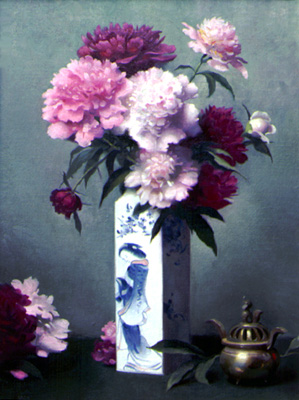
Nationally known artist Richard F. Lack, passed away on Tuesday, September
22, 2009. He is survived by his wife, Katherine; daughter, Susanna
(Michael); sons, Peter (Paulette) and Michael, granddaughter Maren;
extended family and countless friends.
Richard Lack was born in Minneapolis, Minnesota on March 26, 1928,
where he grew up among Scandinavian immigrant families. His father
Fred A. Lack was a dentist whose family emigrated from Germany; his
mother, Mildred Peterson, had parents who came from Norway.
After graduating from Roosevelt High School in 1946, Lack considered
earning an Engineering degree from the University of Minnesota, but
decided to focus instead on his passion for art. His artistic training
began at the Minneapolis School of Art, but his interest in the classical
traditions soon led him to New York City and then to the atelier of
R. H. Ives Gammell in Boston. He is widely considered to be one of
the most versatile and influential pupils of Gammell, with whom he
studied for five years, from 1950 to 1956. Lack’s training was
interrupted by two years of service in the U.S. Army where he was deployed
in the Korean War as an intelligence specialist.
In 1953 Lack met Katherine Vietorisz while studying at Gammell’s
summer studio in Provincetown, Cape Cod. Born in Budapest, Hungary,
Katherine’s parents and siblings immigrated to the United States
shortly after the end of WWII. She was an accomplished artist in her
own right and crafted unique, handmade jewelry. In 1955 Lack traveled
to Europe to study the Old Masters, particularly Peter Paul Rubens,
whose work has greatly influenced him both in style and method. Shortly
after returning he married Katherine.
In 1957 he returned to Minneapolis with his wife, bought a home in
Glen Lake, and built a studio designed to simulate the lighting conditions
recommended in the notebooks of Leonardo da Vinci. There he began to
paint a considerable body of work: still life, portrait, genre, landscape
and paintings based on myth, history and the psychology of C. G. Jung.
The disciplined beauty and striking imagery of Lack’s work and
the importance of his teaching earned him three scholarships from the
Elizabeth T. Greenshields Memorial Foundation in Montreal, Canada as
well as a grant from the John F. and Anna Lee Stacy Scholarship Fund.
Katherine worked as a graphic designer and continued to create exquisite,
handmade jewelry.
In an iconoclastic age often marked by a lack of artistic discipline
and misunderstanding of tradition, Lack fiercely preserved and energetically
perpetuated the tradition he inherited as a member of the “Boston
School,” one of the longest continuing schools of painting in
the history of American art. He was an insightful and provocative advocate
of the Western artistic tradition and his influence as an artist and
educator in preserving the European cultural impact on American art
foreshadowed today’s revived interest in the classical arts.
For 22 years, Lack’s Minneapolis based studio-school provided
a crucial link to the artistic traditions of Europe that rapidly disintegrated
after the First World War. Lack had over 100 students in his full-time
program, training some of the most accomplished and sought-after classical
painters and his atelier acquired an international reputation. Atelier
Lack has become a model for many small studio-schools throughout the
United States and abroad. Lack retired from teaching in 1992. His former
students, Cyd Wicker and Dale Redpath, are carrying on his teaching
legacy at The Atelier in Minneapolis.
During his long career Lack exhibited widely throughout the United
States, in both solo and group exhibitions, winning many awards and
honors. In 1988, the Maryhill Museum of Art in Goldendale, Washington
held a comprehensive and defining retrospective exhibition of his work.
Throughout his career Lack was a highly sought after portrait artist
and he painted many notable figures, among them six portraits for the
Kennedy family in Hyannisport, MA, a portrait for England’s future
Earl of Wilmot and Minnesota Governors Wendell Anderson and Albert
Quie. He received the “Award of Excellence” from the California
Art Club in 1995 for his outstanding work in the field of educating
and encouraging the continuation of Traditional Painting. In 1999 the
American Society of Portrait Artists honored him with their first Founder’s
Award. For many years Lack was a member of the Minnesota Jung Association
and during recent years he devoted most of his time and energy to painting
a series of large works based on Jungian psychology, which depict man’s
inner journey toward individuation and psychological wholeness. He
loved music and was an accomplished violinist, and played for ten years
in the Minnetonka Symphony Orchestra.
Lack coined the term “Classical Realism” in 1982 and it
has since been used throughout the art world in reference to living
painters working within the Western artistic tradition. He was one
of the founding members of The American Society of Classical Realism
and wrote numerous scholarly articles for the Classical Realism
Quarterly and the Classical Realism Journal, as well
as articles in other publications. He edited the book Realism in
Revolution: The Art of the Boston School. His biography, Richard
F. Lack: An American Master, was published in 2001. Lack is listed
in Who’s Who in American Art, Who’s Who in
International Art and Antiques and International Biographies.
His work is in private and public collections throughout the United
States and abroad and he has influenced thousands through his art,
teaching and writing. When the art of the 20th century is finally assessed
with insight and equity, Richard F. Lack’s influence and contribution
will be seen as vital in preserving the great tradition of American
painting.
|

Richard Lack, Peonies
|